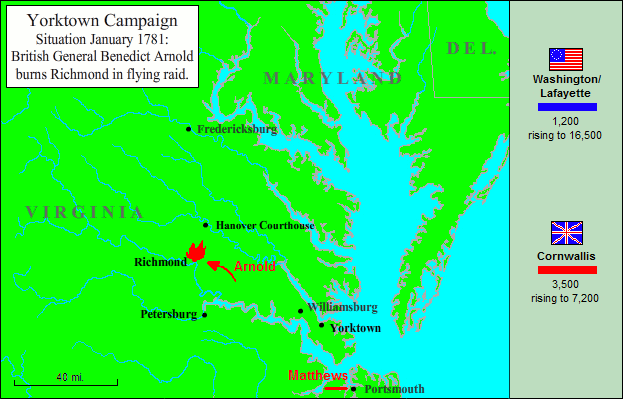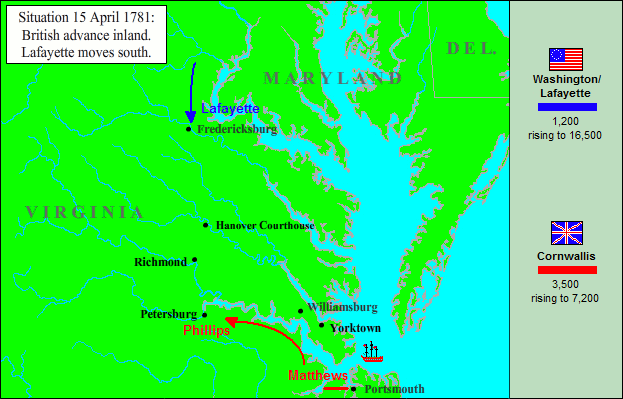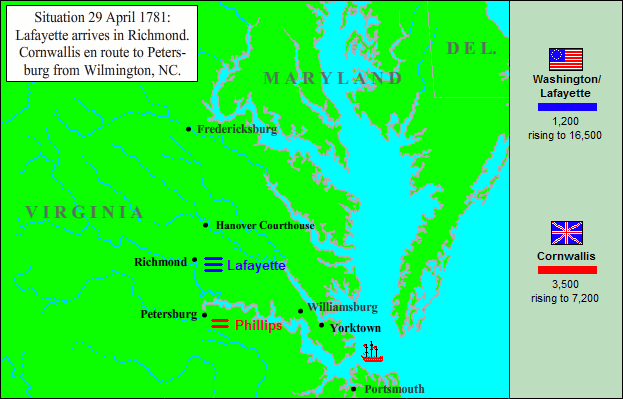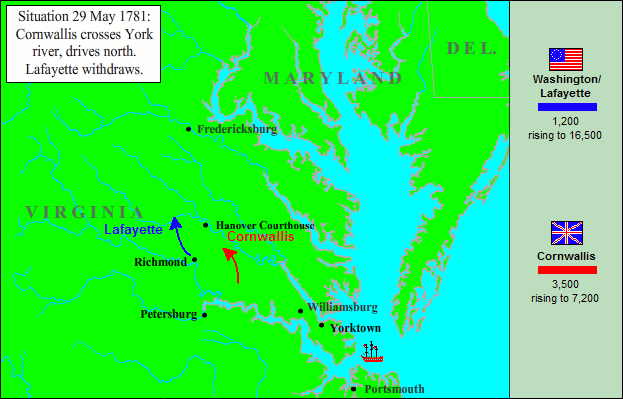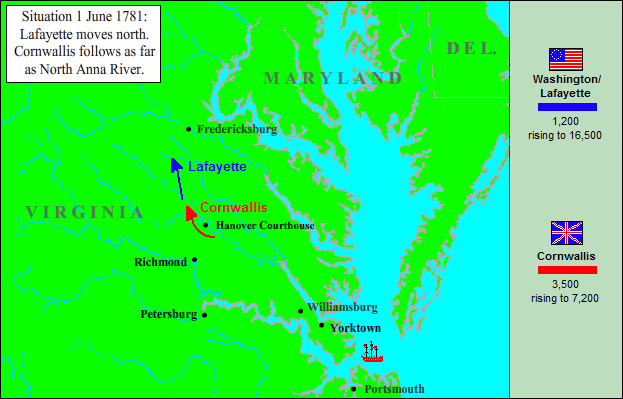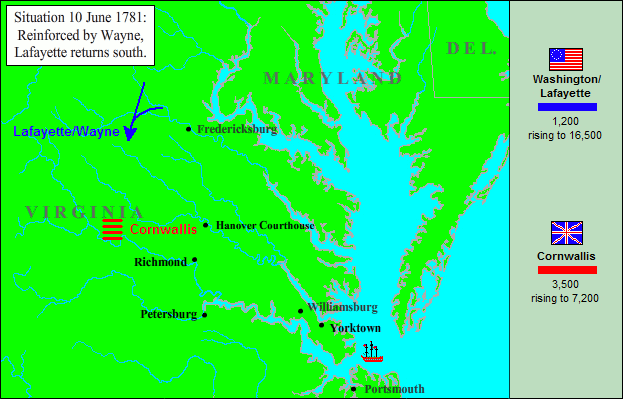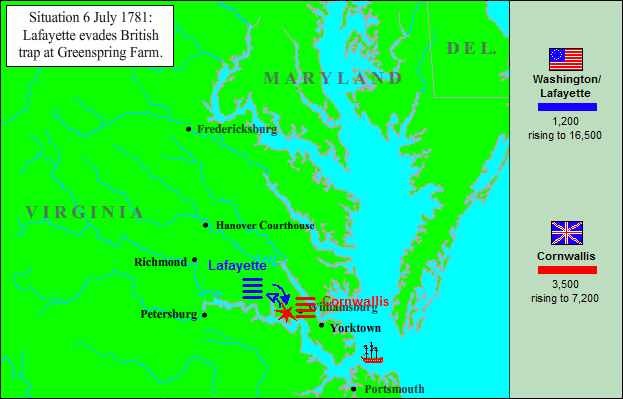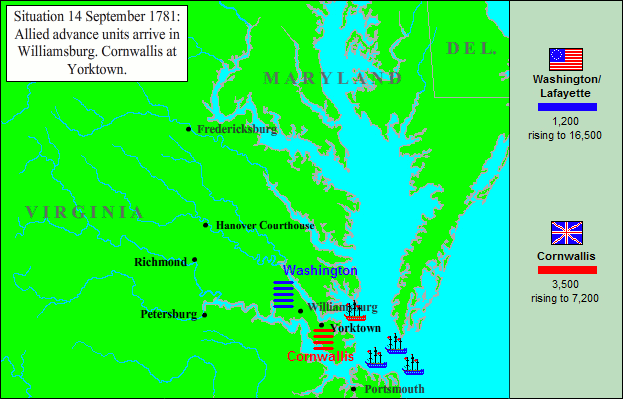Yorktown and Beyond
The General… expects and requires the officers and soldiers… to pursue the duties of their respective departments… with the most unabating ardor. The present moment will decide American independence… [The] liberties of America and the honor of the Allied Arms are in our hands.
–George Washington
The war in the Carolinas Nathanael Greene called the “fugitive war.” It had been a full measure of hard scrabbling, hard marching, and hard fighting over a thousand miles of rough country, and Lord Cornwallis for one was frankly and mightily sick of it. From Wilmington a month after Guilford Court House, he wrote to Sir Henry Clinton of his resolve to make Virginia and the Chesapeake “the seat of war.” Cornwallis’ strategic thinking was, to be charitable, unfinished. He did add in that same dispatch that he was now persuaded that “until Virginia is in a manner subdued, our hold of the Carolinas must be difficult, if not precarious.” The rivers of Virginia, he reasoned, were “advantageous to an invading army; but North Carolina is of all provinces in America the most difficult to attack.” The latter proposition he–and his antagonist General Greene–had already proved. As a plan of future operations, however, the proposal was not a model of clarity. Indeed, the one thing in it that the cautious Clinton saw with clarity was danger. As he wrote to Cornwallis in some dismay, “I dread what may be the consequences of Your Lordship’s move… Had it been possible for Your Lordship to have intimated the probability of your intention… I should certainly have endeavored to have stopped you–as I… consider such a move as likely to be dangerous to our interests in the southern colonies.” It was possible that the Americans might muster something serious in the way of an overland campaign. More troubling though, was the threat from a French fleet on the great bay. To lose control of the Chesapeake even briefly, he warned his staff, “may catch us in very critical movements.”
What the British had accomplished in this theater thus far had been destructive but by no means decisive. In May of 1779 Clinton had sent an amphibious force south out of New York. Redcoats under Major General Edward Matthews came ashore at the mouth of the James, pushed aside a pick-up squad of militiamen, and set to work tearing up the Tidewater. Norfolk, Portsmouth, and Suffolk fell like ripe fruit. The rest of Virginia within Matthews’ reach was even more unfortunate. Plantation homes were looted, then put to the torch along with standing crops. Some 130 ships were either captured or burned to the waterline. Tobacco, the great cash crop of the southland, was not smoked but it was thoroughly burned. When the raid was over, two millions pounds’ worth of Virginia property was ashes or the spoils of war. If this raid counted as success in Clinton’s book, he was not quick in following up on it, but by the winter of 1780 he looked again southward with a more serious hit-and-run effort in mind. The man appointed to do the destruction this time was none other than the traitor Benedict Arnold, in rank anyway a British brigadier general. Wounded twice in the cause of an erstwhile patriotism, he was now in full pursuit of his own deepest and most abiding cause: avarice and ambition. To these he gave his best energies. Landing with 1,200 troops at the handsome Westover Plantation on the James in the first week of 1781, he marched quickly overland to Richmond and torched much of the town. Looting and burning as he went, he pushed on to Westham, where he destroyed an irreplaceable munitions works. He then fell back down the James to winter quarters at Portsmouth, leaving a pillar of flame and a pillar of smoke behind.
General Washington, while keeping a wary eye on Clinton in New York, was likewise looking southward to his native state. He had two objectives in mind, and it is hard to say which he wanted more keenly. Strategically, he wanted something done to defend Virginia from these destructive raids, but he wanted the turncoat Arnold as well. That, he was sure, would be “an event most agreeable to this country.” Washington had held Arnold to be one of the ablest and energetic young officers in the army, and his gallantry at Saratoga spoke for itself. When he recovered from the wound he received there, Washington pressed him back into service as military commander of Philadelphia, expecting that in time he would become with Greene one of his chief lieutenants. Unfortunately, in Philadelphia, the prickly Arnold provoked a running feud with Congress, a quarrel that resulted in his being accused, not without reason, of making private profit out of public business. A court-martial ensued and Arnold was found guilty on two fairly minor counts. Washington, regretfully, gave him a mild reprimand, then offered him a choice of new assignments, unaware that Arnold had been in communication with the British as early as the spring of 1779, preparing to negotiate the price and terms of treason. Nursing bitter resentment, Arnold chose command at West Point, the crucial fortress on the Hudson.
The widowed Arnold had recently married a Philadelphia beauty, Peggy Shippen, daughter of a well-to-do family divided into Whig and Tory factions. Peggy, however, was apolitical: her cause was the main chance, and in this she and her husband were well matched. During the British occupation of Philadelphia, the flirtatious Peggy had cultivated the friendship of Major John Andre, adjutant general of the British army. In the summer of 1780, Sir Henry Clinton made Andre liaison to Arnold in an effort to take by stealth the fortress the British were unlikely to take by storm. On 21 September the armed sloop Vulture carried Andre up the Hudson toward West Point. He crossed American lines in disguise–the disguise contrary to Clinton’s orders–and met Arnold in a Loyalist’s house nearby. Arnold had in hand detailed accounts of the defenses of the American post, for which Andre promised the extravagant sum of 6,000 pounds sterling, and the fateful transaction was accomplished. When Andre returned to the river, however, he discovered to his dismay that the Vulture had been driven off by American artillery. With a pass from Arnold in his hand and the West Point plans hidden in his boot, he started overland for New York.
Near Tarrytown he was brought up short by three ragged American militiamen. These may have been vigilant soldiers; they may simply have intended to plunder a civilian. In any case, they stripped Andre down, found the dispatch in his boot, and hustled him along to the nearest outpost. The post commander seems to have been out of his depth in the matter; he sent Andre’s papers on to General Washington, who was then en route to West Point from Hartford; to Arnold, he sent a letter explaining the circumstances of Andre’s capture and with it the prisoner himself. The letter would reach Arnold but not the prisoner. By chance just then Benjamin Tallmadge, Washington’s intelligence chief, reached the outpost, put two and two together, and seized Andre. The letter, however, went on to the Point and told Arnold all he needed to know. After a brief council with his wife, he headed off in hot haste downriver. There he found the Vulture, still waiting for Andre, and sailed for safety in New York. As Arnold was fleeing West Point, Washington was riding in. There he met Peggy, who treated him to a wonderfully theatrical fit of hysteria and pleaded for her return to Philadelphia. The general was not deceived, but it was too late to catch her husband and so she was granted her freedom. In the week ahead Washington would negotiate with Clinton for an exchange of the spy he wanted to hang for the spy he manifestly did not want to hang. But nothing came of it. On 2 October Andre went to a composed and noble death on the gallows. Arnold would live on in infamy.
To check Arnold’s depredations in Virginia in 1781 and perhaps to catch the predator himself, Washington now called on the Marquis de Lafayette. This vastly wealthy heir to great estates in France was just nineteen when he came to Philadelphia in 1777 to serve the American cause. His first love seems to have been glory, but under the potent spell of Washington, he had fallen in love with liberty. Washington was a shrewd judge of character and was quick to see something in the short, redheaded, pudgy, ungainly youth. He did not look the part of a soldier, that was true, and in fact, his experience was all parade-ground. Still, the commander-in-chief had come to admire his skill, daring, and devotion to the cause. When Lafayette fell wounded at Brandywine, Washington told a surgeon, “Treat him as if he were my son, for I love him as if he were.” Indeed, the young Frenchman became the son Washington never had. (His stepson by Martha was a disappointment to the great man early and late.) The measure of the commander-in-chief’s confidence in the young man was in the magnitude of the assignment he now entrusted to him: in February of 1781 he gave him just 1,200 New England and New Jersey troops and ordered him south to check the growing pressure on Virginia.
Washington’s original plan for Virginia involved another cherished goal of the general: concerted and purposeful cooperation between his armies and his French allies. Much had been attempted: little achieved thus far. This time as Lafayette marched south, the French fleet under Admiral Charles Destouches with 1,200 troops aboard would sail south from Newport to the Chesapeake. With the Americans coming overland down the James and the French sailing up the James in force, Arnold would find himself in a very tight place, perhaps a place on the gallows. But it was not to be. When Destouches reached the mouth of the bay, he met a strong British fleet under the irascible Marriot Arbuthnot, and between the British and bad weather, the French were forced to put to sea again and sail for Newport. Lafayette had urgent need of those soldiers and sailors just then, for the odds against him were growing longer by the day. Clinton sent south another 2,600 Regulars under tough and capable William Phillips (he had seconded Burgoyne on the battle lines of Saratoga). After taking command from the disgruntled Arnold in April, Phillips pushed up the James, drove a thousand Virginia militia before him like a flock of sheep, and plundered Petersburg. More bad news was on the march. About the same time that Phillips was looting Petersburg, Cornwallis was marching out of Wilmington headed for a juncture with his old friend and trusted comrade. (Cornwallis and Phillips had come of age together on the battlefields of Germany in the Seven Years War.) When they met in Petersburg, Cornwallis would have more than 7,000 fighting men in his command. As Lafayette wrote ruefully to Washington, “It now appears I have business with two armies.” Lafayette, like Greene before him, like Washington himself, would have to be content with the glory that came from simply keeping his army in the field and sparring carefully with a superior foe. “Were I to fight a battle,” he understood, “I should be cut to pieces, the militia dispersed, and the arms lost.” Yet the young Frenchman could hardly sit on his hands: “Were I to decline fighting, the country would consider itself given up. I am therefore determined to skirmish, but not to engage too far, and particularly to take care against their immense and excellent body of horse whom the militia fear as they would so many wild beasts…. I am not strong enough even to be beaten.” Coming from a young man–just twenty-three–in his first independent command, it was a cool-headed and calculating assessment.
Lafayette reached Richmond on 29 April, and a timely arrival it was, for Phillips was prepared to push up from Petersburg and burn that place as well. (Petersburg was Phillips’ last post. Some sort of Tidewater fever carried him off soon after.) Lafayette’s advance to Richmond was to be a very temporary check, however. On 20 May Cornwallis came up from Wilmington determined to go in pursuit of the Frenchman. “The boy cannot escape me,” Cornwallis wrote scornfully to Clinton. Indeed, until Lafayette was reinforced, there was nothing he could do really but run, and run he did. Heading north, he slipped swiftly across the South Anna, the North Anna, on to Fredericksburg on the Rappahannock, and finally to Ely’s Ford on the Rapidan. (Lafayette was traveling through country that would be thoroughly fought over in the next rebellion.) Cornwallis followed as far as the North Anna, but at that point he apparently remembered that not so long ago he had marched his army right out of their boots in futile pursuit of Greene. He gave up the chase as bad business and fell back toward the James. While his column withdrew slowly to the south, however, another column was galloping westward. “Bloody Ban” Tarleton was likewise up from Wilmington now and back in the war, leading his dragoons and John Simcoe’s rangers toward Charlottesville. The legislature was even then in session planning for the defense of the state, but the only plan the lawmakers adopted that third of June was to scatter to the four winds. Thomas Jefferson himself, admittedly overwhelmed as war governor, fled just ten minutes ahead of the dragoons, aided by the timely warning of one Jack Jouett who galloped in from the Cuckoo Tavern. (Southerners like to think of Jouett as the Paul Revere of the southland.) While Jefferson’s escape was fortunate, Tarleton’s raid was destructive. Arms, clothing, and supplies destined for Greene in the south went up in flames. Nor was Jefferson’s Monticello spared: the place was shamelessly looted, outbuildings torched, crops burned, cattle, sheep, and hogs slaughtered. And that was not the end of Cornwallis’ cruelty here. Thirty slaves were taken, not to be freed but to be infected with smallpox that might spread to the American camps. Jefferson believed that the British practiced this primitive biological warfare systematically, estimating that some 27,000 African-Americans died of smallpox in Virginia alone. In addition, large numbers of American slaves (precisely how many is not known) were seized and shuffled off in British ships to the West Indies to be exchanged for rum and sugar. In time to come, the British Empire would make an enlightened and vigorous campaign against the traffic in human beings, but that time was not now.
While Jefferson and the legislature fled, however, Lafayette on the Rappahannock was about to turn on the enemy. The reinforcements Washington had ordered down from New York marched into Fredericksburg on 10 June 1781: three solid regiments of the Pennsylvania Line under proven fighter Anthony Wayne. Soon after, Lafayette started his command south, growing in strength as he retraced his retreat from Richmond. By the time he reached the banks of the South Anna, the addition of three brigades of Virginia militia, another 400 Virginia Continentals from Steuben, and 120 horsemen would bring his force to 4,500. Even with his nine little field guns, he was overmatched, but, as he reminded himself, he did not need to win a battle: it would be enough to strike a blow. At the very least, he might show Cornwallis that it was madness to suppose that marching through a country was the same thing as conquering it. Cornwallis had been making his leisurely way down the York Peninsula toward Williamsburg with Lafayette following at a respectful distance, and June was nearly gone before Lafayette found an opportunity to strike. On the 26th Cornwallis pushed out a modest detachment of Queen’s Rangers and Hessian jaegers under John Simcoe. They were to march west from Williamsburg and scoop up American supplies cached on the Chickahominy. They got as far as a little crossroads tavern known as Spencer’s Ordinary when they were struck by a detachment from Lafayette’s army, Pennsylvanians and Virginians backed by a handful of horsemen. A sharp little firefight blew up, and, caught off balance, Simcoe’s men got the worst of it for a time. Indeed, it might have been worse but Lafayette’s force was not crisply handled this day. Simcoe’s command broke off the fight and fell back to Williamsburg, leaving their dead and wounded behind. It was a skirmish or no particular significance except to say to the earl that the Americans remained in his rear and were ready to strike when the occasion offered.
Cornwallis being Cornwallis did not find the “boy’s” presence in his rear threatening. Indeed, he was much more troubled by his commander, Sir Henry Clinton in New York, who kept the Royal Navy busy delivering confusing and contradictory directives. One at least was clear. With Washington camped in an arc opposite Manhattan and the Comte de Rochambeau and the French army landed at Newport, Clinton was growing increasingly anxious about a Franco-American effort against New York. He now wanted Cornwallis to send him 3,000 reinforcements as soon as they could be embarked. The orders were naturally a disappointment to Cornwallis since 3,000 was precisely his margin of superiority over Lafayette. Still, the move might be turned to his advantage before they sailed north. In the first week of July he put his entire army in motion, marching out of Williamsburg and heading south to the Jamestown Ford, which would take them over the James and down to Portsmouth. On 5 July he began crossing baggage and troops to the south bank. The crossing impressed Lafayette and Wayne as an invitation to pitch into a vulnerable column astride a major river. There was one rub, however: Cornwallis intended the crossing–or rather the appearance of a crossing–as an invitation. In fact, very nearly his entire army remained in the woods on the north bank waiting patiently for the Americans to walk into the trap. On 6 July Wayne and 500 of his Continentals walked into it near Greenspring Farm about a half-mile from the ford. Wayne’s command might have been wiped out to the last man if Cornwallis chose to strike with everything he had in one fell swoop. Hoping, however, to lure the “boy” into the trap as well, Cornwallis paused, content for a time to fight a rearguard action against Wayne until Lafayette committed the rest of his army. As the day and the stubborn skirmish at Greenspring Farm wore on, Lafayette pushed his Continentals forward, preparing to support Wayne. Then, unsure of exactly what was in front of him, he held off, sending just 400 ahead to bolster Wayne’s swaying line. It was either shrewd calculation or brilliant intuition because Cornwallis now sprung his trap: out of the timber crashed his heavy lines of battle bent on the utter annihilation of Wayne’s command. They might have succeeded, too, but Wayne, seeing his desperate straights, called for desperate action: a counterattack at the point of the bayonet. As he later wrote, “It was a choice of difficulties. A sudden retreat might end in panic. To await the shock of the approaching enemy would be ruinous.” The Americans stepped out with grim determination, closed within 75 yards, and slammed volleys into the advancing redcoats. The British lines pulled up to answer with volleys of their own, their attack briefly stalled. It was not much of a pause, but enough to give Wayne’s men a chance to fight their way out. Fifteen minutes later the British attack pushed on, broke both of Wayne’s flanks, and sent the whole line reeling–in ragged retreat but not in rout. With sunset came salvation as Cornwallis broke off pursuit in the dark and Wayne’s battle-worn men fell back on Malvern Hill. (Robert E. Lee’s Rebels would take a fearful pounding on these slopes in 1862.) It had been a close thing, but Wayne and Lafayette had kept their wits about them and their men had made a skillful, gritty fight. Cornwallis had killed and wounded 145 of the enemy in this cunning trap not quite sprung. He did not seem to think that he might one day walk into a trap himself.
The next morning the earl crossed the James and marched on to Portsmouth. Even before he reached his destination, however, more correspondence arrived from Clinton. On 8 July, two days after the tussle at Greenspring Farm, a dispatch came in ordering the 3,000 troops to Philadelphia now, not New York. Apparently Clinton reasoned that a move up the Delaware would serve to relieve the pressure on New York. On the 12th, however, a new dispatch arrived ordering the 3,000 to embark for New York after all. Then, on the 20th, yet another dispatch came in ordering the 3,000 to stand down where they were. If the hapless troops who spent a fortnight climbing on and off ships were somewhat bewildered, so was their commander. The same orders that directed them to stand down in Virginia also directed Cornwallis to establish a naval base at Old Point Comfort just north of Hampton Roads at the tip of the peninsula between the James and the York. If possible, the earl should also hold Yorktown on the south bank of the York. When Cornwallis surveyed Old Point Comfort, however, he didn’t like the looks of the place. Since his instructions gave him a measure of discretion and Clinton had designs on Yorktown, Cornwallis now concluded that the quiet, slightly seedy old tobacco port on the York would answer Clinton’s needs for a naval base. On 2 August he began putting troops ashore there and set about the business of fortifying the place as well as Gloucester Point on the opposite shore. With both banks of the York fortified, the fleet at his back, and nothing inland but Lafayette’s corps, Cornwallis could await events in safety. Perhaps Sir Henry Clinton would make the Chesapeake the “seat of war” after all, and sail south with his whole army.


